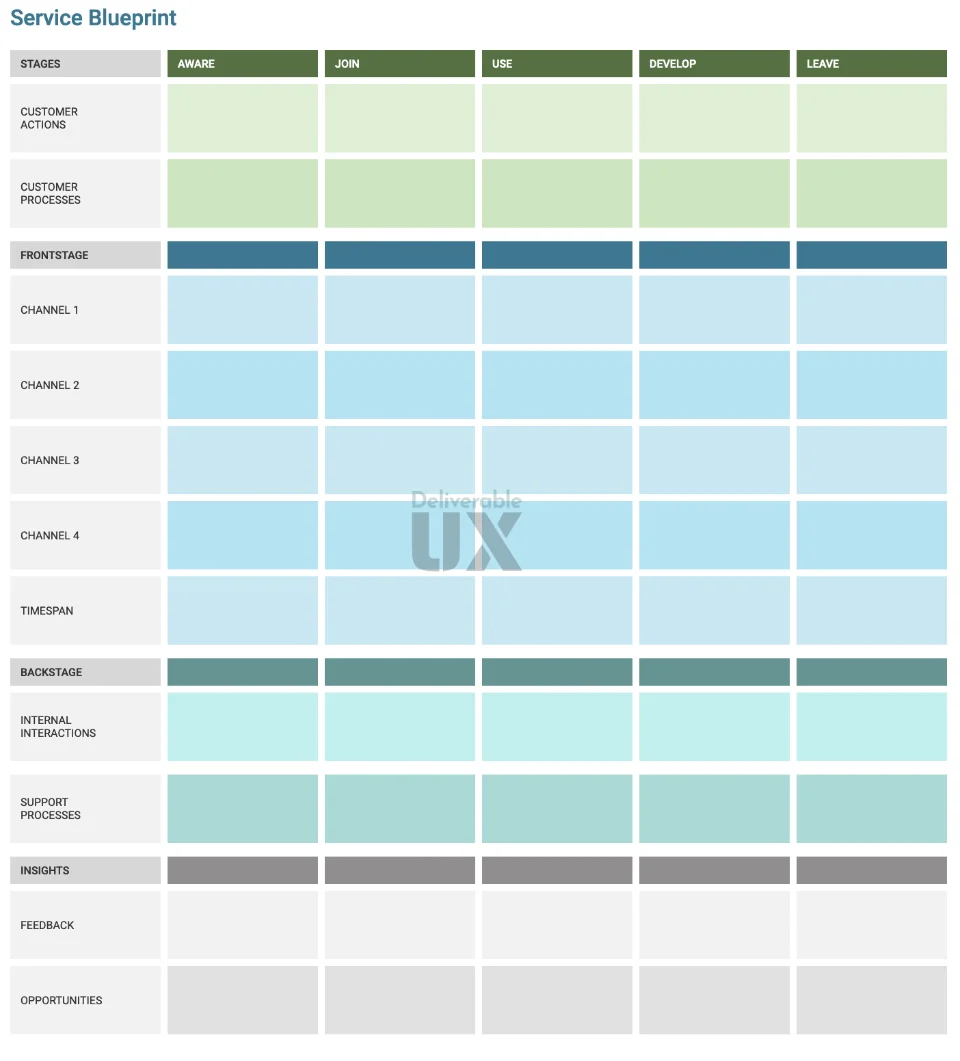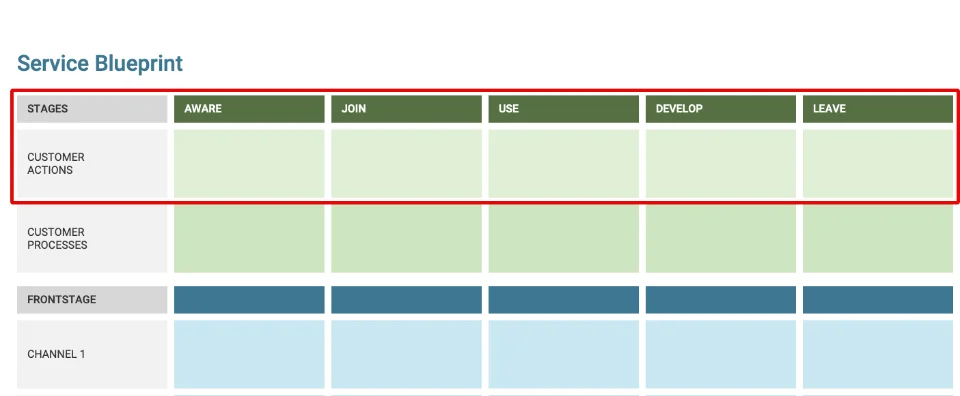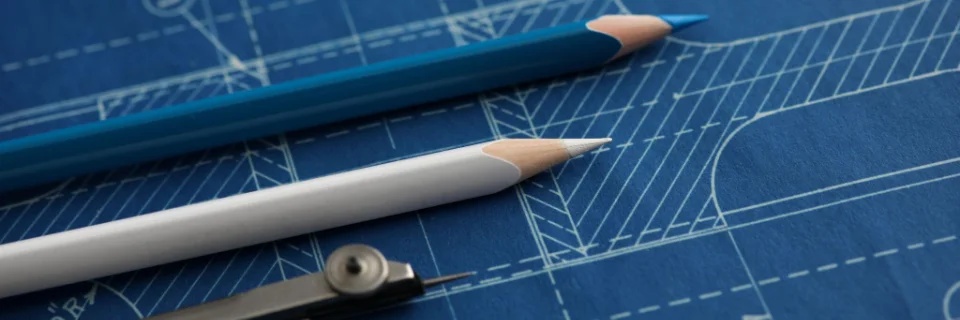Service Blueprinting: Best Practices, Tips, and Tricks
The process of Service Blueprinting can help to improve communication and collaboration between different departments, and it can also help to get more input from employees who are directly involved with the customer experience. In addition, service blueprinting can help to identify areas where employees need more training or support, and it can help to spark innovation and new ideas. Service blueprinting is a valuable tool that can help you to understand your customers better and improve the customer experience overall. Thanks for reading!
Wes Hunt

Service blueprinting is a process that can help you understand how your customers interact with your company and all the different touchpoints they have. It can also help you to identify areas where you can make improvements, and help to improve communication between different departments. Service blueprints have many benefits as we covered in the article "16 Benefits of Service Design & Creating a Blueprint". In this article, we will discuss some of the best practices for service blueprinting, as well as tips and tricks to make the process go more smoothly. We'll also cover some of the common mistakes that people make when doing service design, and how to avoid them.
Service Blueprints are Based on Research
Service design and UX are based on research with real people. Whether those are current, potential, or your competitor's customers it doesn't matter. What matters is if the UX/Service Design activity you are working on isn't based on research, it's not UX.
People are at the core of service design. People build relationships, even with the technology and services around them. They don't just pick up a tool, use it, and keep using it no matter how well the tool works. If that tool "treats them poorly" by wasting their time, being obtuse, or worse abusive, they will hate that tool and by association the organization that created it. By not gathering research when planning a service blueprint, you have no idea what those relationships are.
Your leadership may be resistant to an upfront research effort, especially if they do not have experience around quality blueprints or UX practices. There are levels of insights you can gain to "sell" research for service design:
- Low-Fidelity - Summarize a small sample size of interviews with around 5-6 participants that are well selected. You are purely gathering insights from what the participants say in less than 60-minute interviews. This makes the research phase faster, but it will be shallower.
- Mid-Fidelity - Observation in addition to interviews of participants. These observations can gain more valuable insights that may have longer value to stakeholders beyond the service design project. Use 10-12 participants that are well selected.
- High-Fidelity - Perform more in-depth interviews as well as observation and in-depth analysis. You should gain more valuable insights from this and be able to offer recommendations to stakeholders about improvements.
A high-fidelity research project will result in the most insights. Usually, these offer the most value since the insights are more likely to be useful for other projects. However, you may need to start small and do low-fidelity research on a smaller project to convince leaders to do more on a bigger project.
Service Design is About People
Service design is all about people. It's about understanding how customers interact with your company and identifying areas where you can make improvements. It's also about communication between different departments and making sure that everyone is on the same page when it comes to delivering a great customer experience.
Many companies claim they are customer-centered, yet they do not apply human-centered design to their services, they do not personalize their services for their customers. You do not want your service blueprint to be an exercise in crunching numbers to overlay on top of the business purpose. A good service blueprint should provide insights into how the people involved in the service related to it, both customers and supporting staff.
Service Blueprints are a Team Effort
One of the best practices of Service Blueprinting is to involve employees and stakeholders in its research and creation. The service design process can engage employees and stakeholders from across different groups. This can help to improve communication and collaboration, and it can also help to get more input from those who are directly involved with the customer experience. Service blueprinting can also help to identify areas where employees need more training or support, and it can help to spark innovation and new ideas. A blueprint will not be accurate and in turn useful without input from people involved across the stages and the front and backstage interactions.
Reserve Time for Service Blueprints
One of the best practices for service blueprinting is to make sure that you allow enough time for each stage of the process. This will ensure that you have enough time to do a thorough job, and it will also help to avoid rushed or incomplete blueprints. It can be tempting to rush and base the blueprint off of your own, or a single department's perspective of an entire service. However, this will produce a lower quality design by being inaccurate and probably biased. At the minimum you need to talk to all the teams/departments involved in each stage, and it really should be the people performing the supporting actions. Better, is to also interview customers of the service about their experience.
Service Blueprint Stages are Time Based
Not only do you need to reserve enough time for designing a blueprint, but you should include times for each stage. The stages for a service blueprint should approximate how long someone spends in each stage of a service. Is it minutes for a signup funnel or months for an enterprise sales cycle? This is good to show which stage has the largest time consumption is for a customer and staff.
For example:
- Stage 2 might be a signup process that takes on average 3 minutes for customers to complete.
- Stage 5 involves providing support to existing customers via a call center, the average call is 8 minutes.
Stage 2 can be improved by an estimated 1 month of staff hours to remove 30 seconds from the average signup. Stage 5 can be improved by 1 week of support hours to add better or more FAQs and reduce those phone calls. By both knowing the average time spent in a stage and having quality metrics (see below), stakeholders can make better decisions on what stage has the best ROI on improvements.
Service Blueprints are Iterative
Just like other design processes, service blueprinting should be an iterative process. This means that you should not try to complete the entire blueprint in one go. Instead, you should plan to revisit and revise the blueprint as you get more feedback from employees and stakeholders. This will help to ensure that the final blueprint is accurate and reflects the actual customer experience. If you are an embedded or full-time designer with the organization you should consider the blueprint as more of a living document to be updated as services change and (hopefully) improve.
Include Quality Metrics in Service Blueprints
One of the benefits of service design is that it can help to improve the quality of your products and services. For this to happen, however, you need to include quality metrics in your service blueprints. This will allow you to track the progress that you're making and it will also help to ensure that the customer experience is continually improving. One of the biggest value propositions of a service blueprint is it can tie business metrics with the human-centric aspects of the service experience.
By including baseline metrics and post-change metrics you will increase buy-in from management. If stakeholders, especially leaders, do not see the strategic value behind a design project, it is difficult for them to validate the time spent. High-performing organizations are often data-driven. They are not likely to take the results seriously and act on them without some quantitative evidence alongside any qualitative feedback.
The main tip around metrics is to focus them on customer growth. It is often difficult to nail down ROI on general design changes. Taking a baseline and monitoring customer retention or growth when updating a stage will provide more concrete evidence for service design.1
Include Ideas and Opportunities in the Blueprint
Along with the standard front and backstage sections of a blueprint, we have found adding an "Ideas & Opportunities" section at the bottom to be useful. This can be from the perspective of the research team who did the analysis and insights of the design process. We find this useful to both offer an independent perspective on things to fix, and also spur the review team into suggesting their own opportunities for improvement. Just be sure to base any suggestions on research insights, not your own biases or experiences.
Summary
The process of Service Blueprinting can help to improve communication and collaboration between different departments, and it can also help to get more input from employees who are directly involved with the customer experience. In addition, service blueprinting can help to identify areas where employees need more training or support, and it can help to spark innovation and new ideas. Service blueprinting is a valuable tool that can help you to understand your customers better and improve the customer experience overall. Thanks for reading!
References
- Megan Burns, with Harley Manning and Jennifer Peterson, “Model the ROI of Customer Experience Improvement Projects: A How-To Guide”
Taxonomy:
service blueprints

